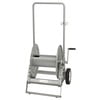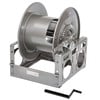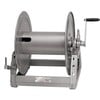Motor Controllers
(743 companies)
Motor controllers receive supply voltages and provide signals to motor drives that are interfaced to motors. They include a power supply, amplifier, user interface, and position control circuitry.
Reels
(621 companies)
...is required to rewind the hose or cable. For electric, hydraulic, and pneumatic rewind reels a motor drives the rewinding of the reel. A spring rewind reel uses an internal spring to rewind the wheel. Features common to reels are portable and collapsible...
Motor Coils
(26 companies)
Motor coils are used with motors, generators, stators, and armatures.
Stepper Motors (rotary)
(437 companies)
Stepper motors use a magnetic field to move a rotor in small angular steps or fractions of steps. They provide precise positioning and ease of use, especially in low acceleration or static load applications.
Motor Bases
(10 companies)
Motor bases are mounts for electric motors. They often include several bolt patterns for various sized motors and a belt tensioning mechanism. Most are designed to fit NEMA motor sizes.
Motor Contactors
(270 companies)
Motor contactors are relays with large current capacity for connecting and disconnecting a motor from the power supply. Typically, motor contractors are multi-pole for control of all current carrying conductors.
Brushless Motors
(292 companies)
Brushless motors are synchronous electric motors that have a magnetically (AC induction) or electronically (DC) controlled commutation system instead of a brush-based mechanical commutation system.
Linear Motors
(190 companies)
Linear motors generate force only in the direction of travel. They are capable of extremely high speeds, quick acceleration, and accurate positioning.
Air Motors
(150 companies)
Air motors are powered by compressed air. They operate at relatively high speeds in industrial and spark-prohibited applications.
Piezoelectric Motors
(20 companies)
Piezoelectric motors use a piezoelectric ceramic element to produce ultrasonic vibrations of an appropriate type in a stator structure. The consequent movement can either be rotational or linear depending on the design of the structure.
Motor Starters and Contactors
(592 companies)
Motor starters and contactors are motor-starting devices. They combine a contactor with overload protection and are designed for starting AC or DC motors.
AC Motor Starters
(283 companies)
AC motor starters are used to turn-on and turn-off electric motors and motor-controlled equipment. They use solid-state or electromechanical technologies, and are designed for single-phase or three-phase motors.
DC Motor Starters
(120 companies)
DC motor starters combine a controller (most often a contactor) with overload protection, allowing a motor or motor-controlled equipment to be turned on and off.
DC Motor Drives
(645 companies)
DC motor drives act as the interface and power supply between a motion controller and a DC motor.
Motor Flange Adapters
(6 companies)
Motor Flange Adapters are used on motors and gearheads to convert standardized flange sizes from one size to another.


